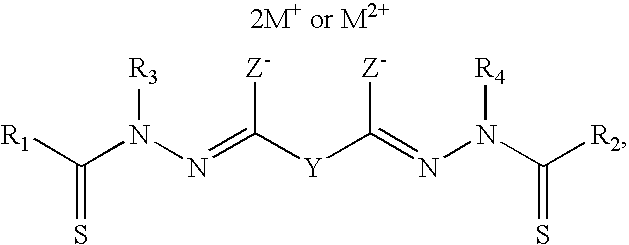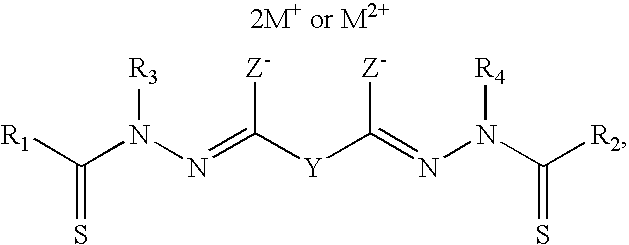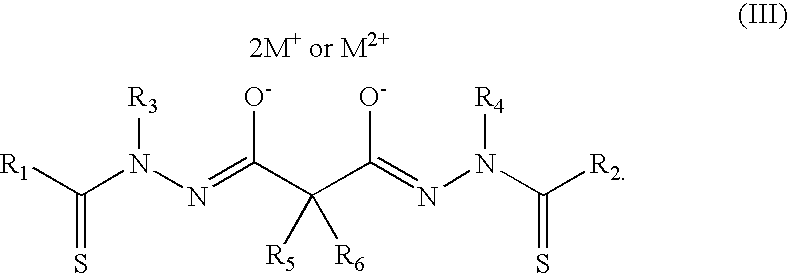Bis(thio-hydrazide amide) formulation
a technology of thiohydrazide and amide, which is applied in the direction of heterocyclic compound active ingredients, biocide, drug compositions, etc., can solve the problems of increasing the cost of drying these disalts, unable to respond to anti-cancer therapy, and unable to achieve the effect of reducing the cost of drying, rapid reconstitution, and high water solubility
- Summary
- Abstract
- Description
- Claims
- Application Information
AI Technical Summary
Benefits of technology
Problems solved by technology
Method used
Image
Examples
example 1
Development of Freeze-drying Parameters
[0147] The freeze-dryer shelf was cooled at 0.1° C. / min, 0.2° C. / min, 0.4° C. / min, 1.0° C. / min, and by rapidly freezing the vials in a −80° C. freezer. The worst looking cakes were produced when the product was frozen in the −80° C. freezer. This thermal treatment yielded a separated layer at the top of the sample referred to as “flake” throughout this study. Flake formation can be likely explained by a much higher resistance of the upper portion of the cake to a gas flow when compared to the material making up the remainder of the cake. A thinner flake separated from the top of the dried cake when the shelves were cooled at 1° C. / min. No flaking was seen using the optimized formulation (as dried using parameters outlined in Table 1) when the shelves were cooled at a rate of 0.1° C. / min, 0.2° C. / min, or 0.4° C. / min. Of note is the fact that other variables were changed when the cooling rate was slowed (e.g., the heating rate during primary dry...
example 2
freeze drying of disodium 2-(N′-methyl-N′-thiobenzoyl-hydrazinocarbonyl)-1-(methyl-thiobenzoyl-hydrazono)-ethanolate and choice of excipients, fill volumes and vial size
[0159] Freeze-drying was performed in a Genesis 25EL freeze-dryer (Virtis). Sample vials were placed directly on the shelf. Space leftover on the shelf was filled with empty vials. The vial headspace was filled with air.
[0160] Tg′ and Tg were evaluated using a PYR1S Diamond DSC. Samples for Tg′ determination were prepared by loading 50 μL of sample into a 50 μL aluminum pan, then sealing the pan using the sealing press. The thermal program used to identify Tg′ (without annealing) was: [0161] 1. Ramp from 20° C. to −50° C. at 10° C. / min [0162] 2. Hold at −50° C. for 4 minutes [0163] 3. Ramp from −50° C. to 20° C. at 10° C. / min
The thermal program used to identify Tg′ that included an annealing step was: [0164] 1. Ramp from 20° C. to −45° C. at 10° C. / min [0165] 2. Hold at −45° C. for 10 minutes [0166] 3. Ramp from ...
example 3
[0184] In a glass beaker 160 g of purified water was heated to approximately 65° C. 9.06 g of hydroxyethyl starch (HES) was slowly added to the water and mixed. Mixing was continued until the HES dissolved (less than 10 minutes). The solution was cooled to room temperature and then 11.70 g of disodium 2-(N′-methyl-N′-thiobenzoyl-hydrazinocarbonyl)-1-(methyl-thiobenzoyl-hydrazono)-ethanolate was added. This was mixed until all the disodium 2-(N′-methyl-N′-thiobenzoyl-hydrazinocarbonyl)-1-(methyl-thiobenzoyl-hydrazono)-ethanolate was in solution (less than 10 minutes). All the solution was quantitatively transferred to a 200 mL volumetric flask and diluted to 200 mL with purified water. The final unit formulation was 55.5 mg / ml STA-4783 sodium and 45 mg / ml HES.
[0185] 8.0 mL of the solution was filled into 20 mL Type I glass vials. Freeze-dry stoppers were placed on the filled vials, which were then loaded into the freeze-dryer. The freeze-drying cycle was as follows in Table 3:
TABL...
PUM
| Property | Measurement | Unit |
|---|---|---|
| pressure | aaaaa | aaaaa |
| pressure | aaaaa | aaaaa |
| temperature | aaaaa | aaaaa |
Abstract
Description
Claims
Application Information
 Login to View More
Login to View More - R&D
- Intellectual Property
- Life Sciences
- Materials
- Tech Scout
- Unparalleled Data Quality
- Higher Quality Content
- 60% Fewer Hallucinations
Browse by: Latest US Patents, China's latest patents, Technical Efficacy Thesaurus, Application Domain, Technology Topic, Popular Technical Reports.
© 2025 PatSnap. All rights reserved.Legal|Privacy policy|Modern Slavery Act Transparency Statement|Sitemap|About US| Contact US: help@patsnap.com



